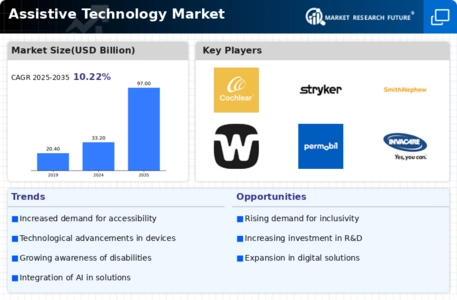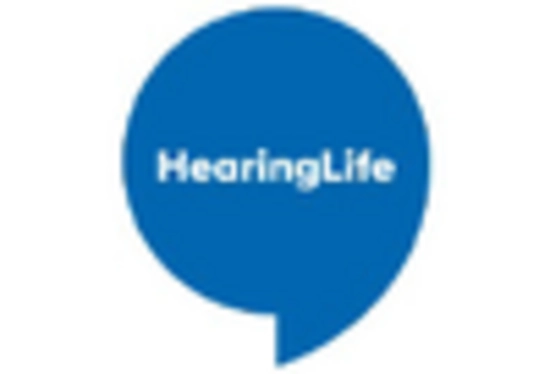The Assistive Technology Market is currently characterized by a dynamic competitive landscape, driven by rapid technological advancements and an increasing demand for inclusive solutions. Major players such as Microsoft (US), Apple (US), and Google (US) are strategically positioned to leverage their extensive resources and innovative capabilities. Microsoft (US) focuses on integrating assistive technologies into its software ecosystem, enhancing accessibility features across its platforms. Apple (US) continues to prioritize user-centric design, ensuring that its products cater to individuals with disabilities. Meanwhile, Google (US) emphasizes artificial intelligence to improve accessibility, particularly through its cloud services and machine learning applications. Collectively, these strategies not only enhance their market presence but also foster a competitive environment that encourages continuous innovation and collaboration.
In terms of business tactics, companies are increasingly localizing manufacturing and optimizing supply chains to enhance responsiveness to market demands. The Assistive Technology Market appears moderately fragmented, with a mix of established players and emerging startups. This structure allows for diverse offerings, yet the influence of key players remains substantial, as they set industry standards and drive technological advancements.
In August 2025, Microsoft (US) announced the launch of a new accessibility toolkit aimed at developers, which is designed to facilitate the creation of inclusive applications. This initiative underscores Microsoft's commitment to fostering an ecosystem where accessibility is a fundamental consideration in software development. By empowering developers with the necessary tools, Microsoft not only enhances its product offerings but also positions itself as a leader in promoting inclusivity in technology.
In September 2025, Apple (US) unveiled a series of enhancements to its VoiceOver feature, which provides spoken descriptions of on-screen content for visually impaired users. This update reflects Apple's ongoing dedication to accessibility and user experience. By continuously refining its assistive technologies, Apple strengthens its brand loyalty among users who prioritize inclusivity, thereby reinforcing its competitive edge in the market.
In October 2025, Google (US) launched a new AI-driven feature within its Google Assistant, designed to assist users with hearing impairments by providing real-time transcription of conversations. This strategic move not only showcases Google's commitment to leveraging AI for accessibility but also positions the company as a frontrunner in integrating advanced technologies into everyday life. Such innovations are likely to enhance user engagement and satisfaction, further solidifying Google's market position.
As of October 2025, the Assistive Technology Market is witnessing trends that emphasize digitalization, sustainability, and the integration of artificial intelligence. Strategic alliances among key players are increasingly shaping the competitive landscape, fostering collaboration that drives innovation. Looking ahead, it is anticipated that competitive differentiation will evolve, shifting from price-based competition to a focus on technological innovation, reliability in supply chains, and the ability to deliver tailored solutions that meet diverse user needs.


















Leave a Comment